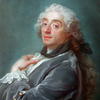More about The Triumph of Venus

Sr. Contributor
Here we have the beautiful, sexy start to a love goddess’ life, set shortly after some bloody violence and dismemberment.
Sometimes birth and family relations are referred to in weirdly poetic terms such as “being born of your father’s loins." In Venus’ case, this phrase is literal and fairly gruesome. The titan Cronus castrated his father Uranus and tossed his severed genitals into the sea. White sea foam sprang forth and produced Venus, also called Aphrodite, the greek word for foam being “aphros.”
As strange as this story may sound, Venus has a lot of competition for weirdest birth story among the Greek gods. Between Athena jumping out of Zeus’s skull and Dionysus being sewn up in his thigh, appearing from sea foam sounds almost normal.
As this painting depicts the myth of Venus’s birth, presumably the “Triumph” referred to in the title is her being born full grown, incredibly sexy, and already surrounded by an adoring fan club. A pretty solid way to start out life.
Boucher’s skill in depicting sensual escapism in mythological scenes, usually featuring Venus, brought him a great deal of popularity and he became a favorite artist of Madame de Pompadour. Madame de Pompadour was fondly referred to by poets as “Venus-Pompadour” and her likeness was captured by Boucher in several portraits.
For the character of Venus though, Boucher used his wife, Marie-Jeanne Boucher, as his primary model. She was known to be very beautiful, similar in features to Madame de Pompadour, and had several admirers of her own. When Boucher sought advice from a friend on finding subjects to portray the myth of Psyche his friend replied by telling him to study his wife. A high compliment, as Psyche was known to be so incredibly beautiful that people began to worship her instead of Venus.
Sources
- Apuleius, and Harold Edgeworth Butler. The Metamorphoses, or Golden Ass. Oxford: Clarendon, 1910.
- Bryan, Michael. Dictionary of Painters and Engravers. New York: Macmillan, 1903.
- Cartwright, Mark. “Athena.” Ancient History Encyclopedia. Ancient History Encyclopedia, May 24, 2012. https://www.ancient.eu/athena/.
- Hagen, Rainer, and Rose-Marie Hagen. What Great Paintings Say Volume 2. Köln: Taschen, 2003.
- Jimenez, Jill. Dictionary of Artists Models. London: Fitzroy Dearborn, 2001.
- The Editors of Encyclopaedia Britannica. “Aphrodite.” Encyclopædia Britannica. Encyclopædia Britannica, inc., February 13, 2019. https://www.britannica.com/topic/Aphrodite -Greek-mythology.
- The Editors of Encyclopaedia Britannica. “Dionysus.” Encyclopædia Britannica. Encyclopædia Britannica, inc., January 25, 2019. https://www.britannica.com/topic/Dionysus.
Featured Content
Here is what Wikipedia says about The Triumph of Venus
The Triumph of Venus is a 1740 oil-on-canvas painting in Rococo style by the French artist François Boucher. It inspired The Birth of Venus by Jean-Honoré Fragonard.
The painting was one of the large number of drawings and paintings acquired by Carl Gustaf Tessin during his stay in Paris, but he had to sell it off part of his collection to the king of Sweden in 1749 after he experienced financial troubles. The painting is now in the Nationalmuseum in Stockholm.
Check out the full Wikipedia article about The Triumph of Venus













